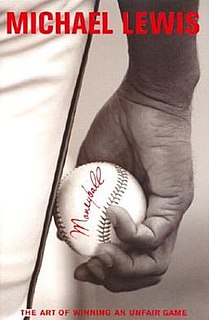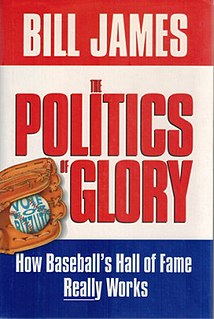Related Research Articles
Sabermetrics or SABRmetrics is the empirical analysis of baseball, especially baseball statistics that measure in-game activity.

George William James is an American baseball writer, historian, and statistician whose work has been widely influential. Since 1977, James has written more than two dozen books devoted to baseball history and statistics. His approach, which he termed sabermetrics in reference to the Society for American Baseball Research (SABR), scientifically analyzes and studies baseball, often through the use of statistical data, in an attempt to determine why teams win and lose.
Pythagorean expectation is a sports analytics formula devised by Bill James to estimate the percentage of games a baseball team "should" have won based on the number of runs they scored and allowed. Comparing a team's actual and Pythagorean winning percentage can be used to make predictions and evaluate which teams are over-performing and under-performing. The name comes from the formula's resemblance to the Pythagorean theorem.

Moneyball: The Art of Winning an Unfair Game is a book by Michael Lewis, published in 2003, about the Oakland Athletics baseball team and its general manager Billy Beane. Its focus is the team's analytical, evidence-based, sabermetric approach to assembling a competitive baseball team despite Oakland's small budget. A film based on Lewis' book, starring Brad Pitt and Jonah Hill, was released in 2011.
A draft is a process used in some countries and sports to allocate certain players to teams. In a draft, teams take turns selecting from a pool of eligible players. When a team selects a player, the team receives exclusive rights to sign that player to a contract, and no other team in the league may sign the player. The process is similar to round-robin item allocation.
The Syracuse Orange are the athletic teams that represent Syracuse University. The school is a member of NCAA Division I and the Atlantic Coast Conference. Until 2013, Syracuse was a member of the Big East Conference.

Baseball Prospectus (BP) is an organization that publishes a website, BaseballProspectus.com, devoted to the sabermetric analysis of baseball. BP has a staff of regular columnists and provides advanced statistics as well as player and team performance projections on the site. Since 1996 the BP staff has also published a Baseball Prospectus annual as well as several other books devoted to baseball analysis and history.

Whatever Happened to the Hall of Fame?: Baseball, Cooperstown, and the Politics of Glory is a book by baseball sabermetrician and author Bill James. Originally published in 1994 as The Politics of Glory, the book covers the unique history of the Baseball Hall of Fame, the evolution of its standards, and arguments for individual players in a typically Jamesian, stat-driven manner. James drives home early on the heated and biased nature of Hall of Fame arguments between fans and writers alike. He states that his goal is not to serve individual players or candidates but to "reinforce the truth in what other people say" and to "serve the argument itself."
Advanced statistics in basketball refers to analyzing basketball statistics through objective evidence. APBRmetrics is a cousin to the study of baseball statistics, known as sabermetrics, and similarly takes its name from the acronym APBR, which stands for the Association for Professional Basketball Research.
Football Outsiders (FO) is a website started in July 2003 which focuses on advanced statistical analysis of the NFL. The site is run by a staff of regular writers, who produce a series of weekly columns using both the site's in-house statistics and their personal analyses of NFL games.
PECOTA, an acronym for Player Empirical Comparison and Optimization Test Algorithm, is a sabermetric system for forecasting Major League Baseball player performance. The word is a backronym based on the name of journeyman major league player Bill Pecota, who, with a lifetime batting average of .249, is perhaps representative of the typical PECOTA entry. PECOTA was developed by Nate Silver in 2002–2003 and introduced to the public in the book Baseball Prospectus 2003. Baseball Prospectus (BP) has owned PECOTA since 2003; Silver managed PECOTA from 2003 to 2009. Beginning in Spring 2009, BP assumed responsibility for producing the annual forecasts, making 2010 the first baseball season for which Silver played no role in producing PECOTA projections.
The Keltner list is a systematic but non-numerical method for considering whether a baseball player is deserving of election to the National Baseball Hall of Fame in Cooperstown, New York. Developed by baseball statistician Bill James, it makes use of an inventory of questions regarding the merit of players relative to their peers. Enshrinement in the Hall of Fame is the highest honor in baseball, with only 236 players having been inducted as of 2012. Election to the Hall is also permanent. However, selection for the Hall is by election; no "cut-offs" or objective criteria exist. It can therefore be difficult for voters and fans alike to determine which former players are deserving of the honor.

William Joseph Pecota is a former Major League Baseball infielder. He is the namesake of PECOTA, a sabermetric created by Nate Silver and owned by Baseball Prospectus.

The Texas Sports Hall of Fame recognizes athletes, coaches, and administrators who have made "lasting fame and honor to Texas sports". It was established in 1951 by the Texas Sports Writers Association. Once it made its first induction in 1951, Texas became the first U.S. state to have a sports hall of fame.
The Hidden Game of Football is an influential book on American football statistics published in 1988 and written by Bob Carroll, John Thorn, and Pete Palmer. It was the first systematic statistical approach to analyzing American football in a book and is still considered the seminal work on the topic.

Muthu Alagappan is a medical resident known for his professional basketball analytics. He was born in England and raised in Texas. During college at Stanford University, he began an internship at big data startup company Ayasdi, where he leveraged their software on basketball statistics to determine 13 distinct positions of play. After speaking at the 2012 MIT Sloan Sports Analytics Conference, several professional teams began to use the company's software. He was given the top prize at the conference, and GQ called his work both "a new frontier for the NBA" and "Muthuball"—an allusion to Moneyball baseball statistical analysis known for revolutionizing the sport. Forbes included him in their 2012 and 2013 "30 Under 30" list of influential people in the sports industry. His work has received mention in The New York Times, ESPN, The Wall Street Journal, Wired, and Slate.

The Butler Grizzlies are the sports teams of Butler Community College located in El Dorado, Kansas, United States. They participate in the National Junior College Athletic Association (NJCAA) and in the Kansas Jayhawk Community College Conference.
Advanced metrics is the term for the empirical analysis of sports, particularly statistics that measure in-game productivity and efficiency. Advanced metrics were first employed in baseball by Bill James, a pioneer in the field who is considered the father and public face of the practice.
The Jaffe Wins Above Replacement Score, commonly abbreviated JAWS, is a sabermetric baseball statistic developed to evaluate the strength of a player's career and merit for induction into the Baseball Hall of Fame. Created by averaging a player's career WAR with their 7-year peak WAR, its "stated goal is to improve the Hall of Fame's standards, or at least to maintain them rather than erode them, by admitting players who are at least as good as the average Hall of Famer at the position, using a means via which longevity isn't the sole determinant of worthiness."
References
- ↑ Aaron Schatz, "Hard Times for the Class of '96", FootballOutsiders.com (July 8, 2004).